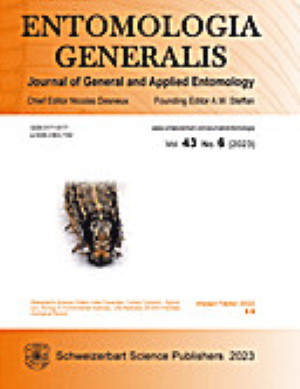The invasive tomato pest Tuta absoluta can transmit the emergent tomato brown rugose fruit virus
IF 4.6
1区 农林科学
Q1 ENTOMOLOGY
引用次数: 0
Abstract
The tomato brown rugose fruit virus (ToBRFV) currently represents one of the most significant threats to tomato crop worldwide. Its transmission occurs mainly through contact between plants and infected surfaces, and only one case of mechanical transmission by arthropods has been reported. Here, we aim to assess the role of an invasive tomato pest, Tuta absoluta (Meyrick) (Lepidoptera: Gelechiidae), in ToBRFV transmission. Laboratory tests demonstrated the presence of the ToBRFV in adult moths obtained from larvae developed on ToBRFV-infected plants. Infected adults of T. absoluta were able to infect healthy tomato plants. In order to evaluate whether the occurrence of ToBRFV on T. absoluta adults was internal or external to the pupae, as results of larvae feeding on infected plants, pupae obtained from larvae fed on infected plants were externally disinfected and then analyzed for the presence of ToBRFV by RT-qPCR. Adults obtained from disinfected and not-disinfected pupae were also analyzed. Both adults and pupae were positive for the virus, suggesting its presence in the inner surface of the pupal exuvia. Electron microscopy, western blot analyses and hemolymph bioassay showed the absence of ToBRFV virions and viral coat protein in the hemolymph collected from disinfected pupae, demonstrating that the ToBRFV is not circulative in the progeny of T. absoluta adults obtained from larvae fed in infected plants, but probably adults got contaminated during their emergence, due to virus presence in the inner surface of pupal exuvia. This study demonstrates for the first time that T. absoluta can carry an infectious primary inoculum of ToBRFV, highlighting a potential epidemiological role of T. absoluta in spreading ToBRFV in the field.入侵番茄的害虫 Tuta absoluta 能传播新出现的番茄褐皱纹果病毒
番茄褐皱纹病毒(ToBRFV)是目前全球番茄作物面临的最严重威胁之一。它主要通过植物与受感染表面的接触传播,目前仅有一例通过节肢动物机械传播的报道。在此,我们旨在评估入侵番茄的害虫 Tuta absoluta (Meyrick) (鳞翅目:Gelechiidae)在 ToBRFV 传播中的作用。实验室测试表明,从受 ToBRFV 感染的植物上发育的幼虫中获得的成蛾体内存在 ToBRFV。受感染的 T. absoluta 成虫能够感染健康的番茄植株。为了评估 T. absoluta 成虫身上的 ToBRFV 是发生在蛹的内部还是外部,作为幼虫取食受感染植物的结果,对取自取食受感染植物的幼虫的蛹进行了外部消毒,然后通过 RT-qPCR 分析是否存在 ToBRFV。同时还分析了从已消毒和未消毒蛹中获得的成虫。成虫和蛹都对病毒呈阳性反应,表明病毒存在于蛹的外膜内表面。电子显微镜、Western 印迹分析和血淋巴生物测定表明,从消毒蛹中采集的血淋巴中没有 ToBRFV 病毒和病毒衣壳蛋白,这表明从在受感染植物中喂养的幼虫中获得的 T. absoluta 成虫的后代中没有 ToBRFV 病毒,但成虫可能在萌发过程中受到了污染,这是因为蛹的蜕皮内表面存在病毒。这项研究首次证明了绝对蝇可携带具有传染性的 ToBRFV 初代接种体,突出了绝对蝇在田间传播 ToBRFV 的潜在流行病学作用。
本文章由计算机程序翻译,如有差异,请以英文原文为准。
求助全文
约1分钟内获得全文
求助全文
来源期刊

Entomologia Generalis
生物-昆虫学
CiteScore
7.10
自引率
18.80%
发文量
72
审稿时长
>12 weeks
期刊介绍:
Its scope covers all aspects of basic and applied research dealing with insects and more broadly with arthropods inhabiting wild, agricultural and/or urban habitats. The journal also considers research integrating various disciplines and issues within the broad field of entomology and ecology.
Entomologia Generalis publishes high quality research articles on advances in knowledge on the ecology and biology of arthropods, as well as on their importance for key ecosystems services, e.g. as biological control and pollination. The journal devotes special attention to contributions providing significant advances (i) on the fundamental knowledge and on sustainable control strategies of arthropod pests (including of stored products) and vectors of diseases, (ii) on the biology and ecology of beneficial arthropods, (iii) on the spread and impact of invasive pests, and (iv) on potential side effects of pest management methods.
Entomologia Generalis welcomes review articles on significant developments in the field of entomology. These are usually invited by the editorial board, but proposals may be sent to the Editor-in-Chief for preliminary assessment by the editorial board before formal submission to the journal. The journal also considers comments on papers published in Entomologia Generalis, as well as short notes on topics that are of broader interest.
 求助内容:
求助内容: 应助结果提醒方式:
应助结果提醒方式:


